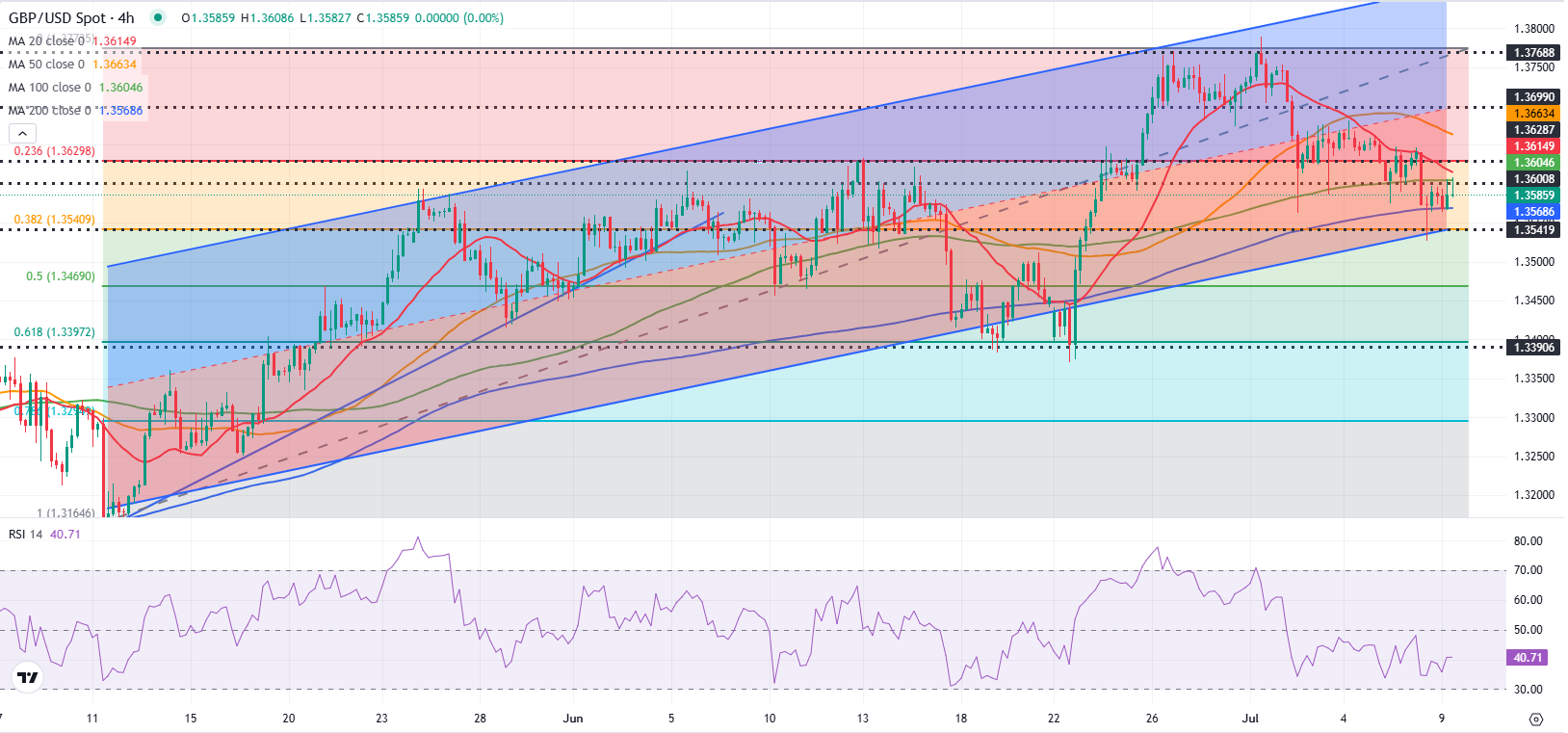- GBP/USD fluctuates at around 1.3600 in the European session on Wednesday.
- Technical sellers could remain interested once 1.3600 is confirmed as resistance.
- An improving risk mood could help the pair limit its losses.
GBP/USD recovered after setting a two-week low and closed virtually unchanged on Tuesday. The pair moves up and down in a narrow band at around 1.3600 midweek, while the technical picture doesn’t offer any signs of a steady recovery.
British Pound PRICE This week
The table below shows the percentage change of British Pound (GBP) against listed major currencies this week. British Pound was the weakest against the US Dollar.
| USD | EUR | GBP | JPY | CAD | AUD | NZD | CHF | |
|---|---|---|---|---|---|---|---|---|
| USD | 0.68% | 0.51% | 1.76% | 0.68% | 0.50% | 1.13% | 0.35% | |
| EUR | -0.68% | -0.16% | 0.84% | -0.02% | -0.12% | 0.43% | -0.35% | |
| GBP | -0.51% | 0.16% | 0.96% | 0.16% | 0.04% | 0.60% | -0.31% | |
| JPY | -1.76% | -0.84% | -0.96% | -0.83% | -1.02% | -0.40% | -1.32% | |
| CAD | -0.68% | 0.02% | -0.16% | 0.83% | -0.16% | 0.45% | -0.49% | |
| AUD | -0.50% | 0.12% | -0.04% | 1.02% | 0.16% | 0.66% | -0.35% | |
| NZD | -1.13% | -0.43% | -0.60% | 0.40% | -0.45% | -0.66% | -0.90% | |
| CHF | -0.35% | 0.35% | 0.31% | 1.32% | 0.49% | 0.35% | 0.90% |
The heat map shows percentage changes of major currencies against each other. The base currency is picked from the left column, while the quote currency is picked from the top row. For example, if you pick the British Pound from the left column and move along the horizontal line to the US Dollar, the percentage change displayed in the box will represent GBP (base)/USD (quote).
The uncertainty surrounding the United States’ trade relations and their potential impact on growth and inflation outlook causes markets to cling to a cautious stance. In turn, the US Dollar (USD) finds demand as a safe-haven and stays resilient against its rivals.
US President Donald Trump said late Tuesday that the BRICS members will be subject to 10% tariff rate and added that they will be introducing tariffs on pharmaceuticals and semiconductors soon. Meanwhile, US Commerce Secretary Howard Lutnick said that another 15 to 20 tariff letters are expected to be announced in the next two days.
In the second half of the day, the Federal Reserve will release the minutes of the June policy meeting. Following the upbeat June employment data from the US, the probability of the Fed cutting the policy rate by 25 basis points in July dropped to nearly 5% from about 25%, as per CME FedWatch Tool. Hence, the publication is unlikely to alter market expectations in a significant way.
Investors will continue to pay close attention to the risk perception. After trading flat earlier in the session, US stock index futures turned positive on the day. A bullish opening in Wall Street could hurt the USD and open the door for a rebound in the near term.
GBP/USD Technical Analysis

The 100-period Simple Moving Average (SMA) on the 4-hour chart aligns as a pivot level at 1.3600. In case GBP/USD confirms that level as resistance, 1.3570 (200-period SMA) could be seen as the next support level before 1.3540 (lower limit of the ascending channel, Fibonacci 38.2% retracement of the latest uptrend) and 1.3500 (static level, round level).
On the upside, 1.3630 (Fibonacci 23.6% retracement) could be seen as the first resistance level ahead of 1.3660 (50-period SMA) and 1.3700 (mid-point of the ascending channel).
Pound Sterling FAQs
The Pound Sterling (GBP) is the oldest currency in the world (886 AD) and the official currency of the United Kingdom. It is the fourth most traded unit for foreign exchange (FX) in the world, accounting for 12% of all transactions, averaging $630 billion a day, according to 2022 data.
Its key trading pairs are GBP/USD, also known as ‘Cable’, which accounts for 11% of FX, GBP/JPY, or the ‘Dragon’ as it is known by traders (3%), and EUR/GBP (2%). The Pound Sterling is issued by the Bank of England (BoE).
The single most important factor influencing the value of the Pound Sterling is monetary policy decided by the Bank of England. The BoE bases its decisions on whether it has achieved its primary goal of “price stability” – a steady inflation rate of around 2%. Its primary tool for achieving this is the adjustment of interest rates.
When inflation is too high, the BoE will try to rein it in by raising interest rates, making it more expensive for people and businesses to access credit. This is generally positive for GBP, as higher interest rates make the UK a more attractive place for global investors to park their money.
When inflation falls too low it is a sign economic growth is slowing. In this scenario, the BoE will consider lowering interest rates to cheapen credit so businesses will borrow more to invest in growth-generating projects.
Data releases gauge the health of the economy and can impact the value of the Pound Sterling. Indicators such as GDP, Manufacturing and Services PMIs, and employment can all influence the direction of the GBP.
A strong economy is good for Sterling. Not only does it attract more foreign investment but it may encourage the BoE to put up interest rates, which will directly strengthen GBP. Otherwise, if economic data is weak, the Pound Sterling is likely to fall.
Another significant data release for the Pound Sterling is the Trade Balance. This indicator measures the difference between what a country earns from its exports and what it spends on imports over a given period.
If a country produces highly sought-after exports, its currency will benefit purely from the extra demand created from foreign buyers seeking to purchase these goods. Therefore, a positive net Trade Balance strengthens a currency and vice versa for a negative balance.

